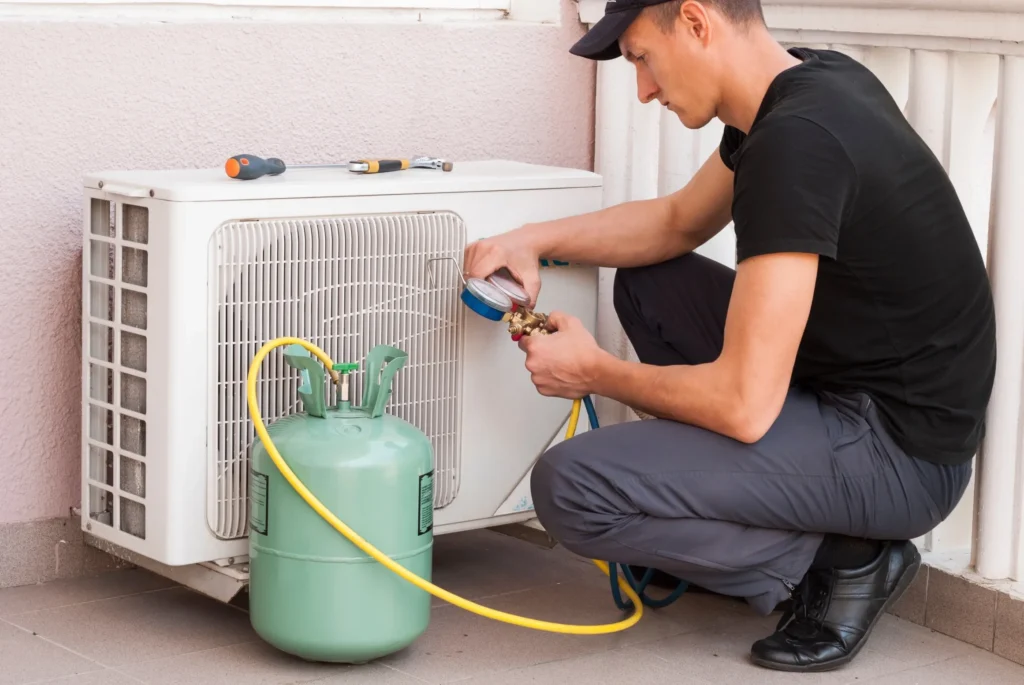How to Check Freon Level
To check Freon level, use a pressure gauge on the low side port of the AC system. Monitoring the gauge will indicate the coolant level status.
Ensuring the Freon level in your AC system is essential for optimal performance and efficiency. Maintaining the correct Freon level helps prevent damage to the compressor and ensures your AC functions effectively. Regularly checking the Freon level also helps identify any potential leaks early on, preventing costly repairs in the future, and ensuring your system operates smoothly.
By following simple steps to monitor the Freon level, you can keep your AC system running efficiently and effectively, providing cool and comfortable air throughout your space.
Gauging Freon Levels
To check the Freon level in your HVAC system, use a pressure gauge and attach it to the service valve. Make sure the system is running and you have a refrigerant chart to compare the readings. If the levels are low, consult a professional to add more Freon.
Regular maintenance is crucial to ensure peak performance.
Checking the freon level in your air conditioning system is essential for its proper functioning and efficiency. Freon, also known as refrigerant, is responsible for absorbing and releasing heat, cooling the air before it is circulated back into your living space. Over time, freon levels can become low due to leaks or system inefficiencies. Gauging freon levels helps you determine if your air conditioner requires a recharge, preventing the unit from working harder than necessary and incurring costly repairs. In this section, we will explore two methods of gauging freon levels: checking for signs of low freon and using a pressure gauge.Checking For Signs Of Low Freon
Before using a pressure gauge, it’s helpful to look for signs that your air conditioner may be low on freon. These signs can be indicators that your system is not cooling effectively or efficiently. Some common signs of low freon include:- Warm air blowing from the vents instead of cold air
- Lack of airflow or weak airflow from the vents
- Icing or frost on the evaporator coil
- Unusual hissing or bubbling noises coming from the unit
- An increase in energy bills without a change in usage
- Switch off your air conditioning unit and allow it to cool down
- Locate the service ports on your air conditioner. These ports are usually found on the refrigerant lines near the condenser unit.
- Remove the caps from the service ports, being careful not to lose them
- Attach the pressure gauge hoses to the service ports. The high-pressure hose usually has a red connector, while the low-pressure hose has a blue connector. Ensure that you connect the hoses correctly.
- Read the pressure gauge. The gauge will display the pressure readings for the high-pressure and low-pressure sides of the system. Refer to your air conditioner’s manual for the recommended pressure ranges.
- If the pressure readings are outside the recommended range, it may indicate that your system has low or high freon levels. It is best to consult a professional HVAC technician to accurately diagnose the issue and address any necessary repairs or recharge.
- Disconnect the pressure gauge hoses and securely reseal the service ports with the caps.

Credit: www.way.com
Identifying Signs Of Low Freon
Recognizing Inadequate Cooling
One noticeable sign of low Freon is insufficient cooling in your space, especially on hot days.
Observing Ice Build-up
If you see ice formation on your air conditioning unit or refrigerant lines, it could indicate low Freon.
Using A Pressure Gauge
Using a Pressure Gauge is an essential method to check the Freon level in your vehicle’s air conditioning system. The process involves locating the Low-Pressure Side Valve and connecting the gauge to accurately read the pressure.
Locating The Low-pressure Side Valve
- Find the low-pressure side valve near the air conditioning compressor.
- Ensure the engine is running and the AC is turned on to locate the valve easily.
- The low-pressure side valve is typically marked with an “L” or “Low” on the cap.
Connecting The Gauge And Reading The Pressure
- Remove the valve cap and securely connect the pressure gauge to the valve.
- Refer to the gauge’s instructions to ensure a proper connection.
- Observe the pressure reading on the gauge to determine the Freon level.

Credit: www.youtube.com
Monitoring And Maintenance
It is crucial to conduct regular inspections of your HVAC system to ensure that the Freon levels are at the right level. Regular inspections help in identifying any potential issues that may arise and prevent major problems in the long run. By checking the Freon levels periodically, you can avoid any system malfunctions, reduce energy consumption, and increase the lifespan of your HVAC system.
While regular inspections are essential, it is also advisable to consult a professional HVAC technician for checking the Freon levels. These professionals have the knowledge and expertise to accurately measure and monitor the Freon levels in your system. They have the necessary tools and equipment that can provide accurate readings and diagnose any underlying issues with your HVAC system. By consulting a professional, you can ensure that your system remains in optimal condition and avoid any potential damages.
Wrapping Up
Proper maintenance of your air conditioning system’s freon level is crucial to ensure its optimal performance. By regularly checking the freon level, you can prevent potential issues and prolong the lifespan of your unit. Let’s recap the key steps you need to follow and understand the importance of maintaining proper freon levels.
Recap Of Key Steps
- Turn off the air conditioner and let it sit for at least 15 minutes.
- Locate the service valves on the refrigerant lines.
- Attach a pressure gauge to the service valves to check the freon level.
- Compare the pressure reading to the manufacturer’s recommended levels.
- If the freon level is low, contact a professional to recharge the system.
Importance Of Proper Freon Levels
Maintaining the correct freon level is essential for the efficient and effective operation of your air conditioning system. Proper freon levels ensure that your AC unit can efficiently cool your home without putting excessive strain on the system. Inadequate freon levels can lead to decreased cooling performance, higher energy consumption, and potential damage to the compressor. Regularly monitoring and maintaining the freon level can prevent costly repairs and extend the longevity of your air conditioner.

Credit: www.meadowair.com
Frequently Asked Questions On How To Check Freon Level
How Do You Check If Your Freon Is Low?
To check if your Freon is low, you can use a pressure gauge designed for air conditioning systems. Connect the gauge to the low-pressure port and check the reading. If it is below the recommended level, your Freon may be low and needs to be recharged by a professional technician.
Can You Check Freon Level Yourself?
No, it’s not recommended. Checking Freon levels requires specialized equipment and training. Contact a professional HVAC technician for accurate evaluation.
How Do You Know If Ac Unit Needs Freon?
Signs your AC unit needs Freon: weak airflow, warm air, ice buildup on coils, hissing sounds, elevated energy bills.
How Do You Check Air Freon?
To check the air Freon, follow these steps: 1. Turn off the air conditioner and let it sit for at least 15 minutes. 2. Locate the service valves on the air conditioning unit. 3. Attach a pressure gauge to the low-pressure service valve.
4. Read the pressure on the gauge and compare it to the manufacturer’s specifications. 5. If the pressure is too low or too high, contact a professional to recharge or service the air conditioner.
When Should I Check The Freon Level In My Air Conditioner?
It’s essential to check the Freon level at least once a year to ensure optimal cooling performance.
What Are The Signs Of Low Freon Levels In An Air Conditioner?
Look out for reduced cooling efficiency, ice buildup on the refrigerant lines, and strange hissing noises.
How Can I Visually Inspect The Freon Level In My Air Conditioner?
Inspect the refrigerant lines for any frost or ice buildup, which could indicate a low Freon level.
Conclusion
Checking the Freon level in your AC unit is crucial for ensuring optimal cooling performance. By following the steps outlined in this blog post, you can easily determine whether your AC has enough refrigerant or if it needs a recharge.
Remember to always prioritize safety by turning off the power before starting any maintenance tasks. Regularly checking and maintaining the Freon level will help prolong the lifespan of your AC, improve energy efficiency, and prevent costly repairs. Stay cool and comfortable all summer long!

